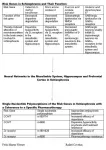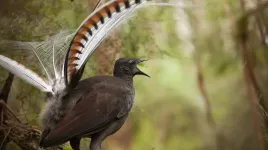(Press-News.org) Bladder cancer is more aggressive and more advanced in South Texas residents than in many parts of the country, a study by the Mays Cancer Center, home to UT Health San Antonio MD Anderson, indicates.
The disease is also deadlier in Latinos and women, regardless of where they live nationwide, according to the research.
The team from The University of Texas Health Science Center at San Antonio (UT Health San Antonio), which includes the Mays Cancer Center, compared bladder cancer cases in the Texas Cancer Registry with cases in the Surveillance, Epidemiology and End Results (SEER) Program. SEER, which collects data on cancer cases from various locations and sources across the U.S., does not include Texas statistics.
Cases covered the years 1995 to 2015. The South Texas cohort consisted of 11,027 bladder cancer cases from a 38-county region extending from San Antonio to Laredo to the Lower Rio Grande Valley to Corpus Christi. The statewide cohort totaled 68,415 cases from all 254 Texas counties. The SEER cohort consisted of 155,701 cases from Alaska; Connecticut; Detroit; Atlanta; rural Georgia; San Francisco-Oakland, Calif.; San Jose-Monterey, Calif.; Hawaii; Iowa; Los Angeles; New Mexico; Seattle-Puget Sound; and Utah.
Worse survival rates
"Although South Texas and Texas had lower bladder cancer incidence rates than SEER, the region and state had significantly worse five-year survival rates for bladder cancer compared to SEER. This was regardless of gender," said study first and corresponding author Shenghui Wu, MD, PhD, MPH, assistant professor of population health sciences at UT Health San Antonio.
"We also found that Latinos, both men and women, had lower incidence but worse survival than non-Latino whites in each geographical area," Dr. Wu said. "And women had significantly lower bladder cancer incidence but worse survival rates than men, regardless of race or ethnicity, in each area."
She said the researchers have a long way to go to know which factors affect bladder cancer survival. In the journal article, the authors wrote: "The residents in South Texas have lower per capita personal incomes; higher rates of unemployment, poverty and lack of insurance; lower educational attainment; less access to health care services; and higher obesity prevalence than the state as a whole, which may uniquely impact both incidence and survival rates for cancer patients."
Unique differences that need to be studied
UT Health San Antonio urologist Robert Svatek, MD, a study coauthor, said the findings reveal the complex variations among diverse groups in their responses to cancer. The Texas population, which is 40% Latino, "is uniquely different than the rest of the United States in the biology of bladder cancer," Dr. Svatek said. "It means we really need to understand what is going on locally and study our patients to understand why there is a difference."
More than 4,780 people in Texas will develop bladder cancer in 2021, the American Cancer Society estimates. Because it bleeds, this form of cancer rarely goes undetected. Symptoms include blood in the urine and urinary pain. People with bladder cancer typically need follow-up tests for years after treatment to look for recurrence.
One form of the disease responds well to treatment and patients don't lose the bladder. Another form requires chemotherapy, surgery and sometimes radiation, and only 50% of patients survive it. "There are different forms, there is a spectrum," Dr. Svatek said.
Smoking contributes to bladder cancer development, but other factors aren't known. For this reason, it is necessary and important to do a bladder cancer survival study, which Dr. Wu is designing to find factors affecting survival in South Texas.
"This first study and the ones to come will make an important contribution to the literature because there is not a lot known about Latinos and bladder cancer," Dr. Svatek said.
Knowledge a step toward improving survival
Study findings will have relevance to health care services planning, Dr. Wu noted.
"Hopefully our research will help communities by first determining the high-risk populations and then understanding the ways to improve bladder cancer survival and quality of life and decrease mortality rates," she said.
The research was published in December in the journal Bladder Cancer.
Dr. Svatek, professor and chairman of urology in the Joe R. and Teresa Lozano Long School of Medicine, treats bladder cancer in Mays Cancer Center patients and leads clinical trials of new bladder cancer therapies. The Mays Cancer Center employs a co-management team of multiple experts focusing on each bladder cancer patient. The center is one of the country's leading sites enrolling Latinos into clinical trials.
"These findings are crucial and aligned with the fundamental focus of the Mays Cancer Center to advance the science of cancer in Latinos," said Ruben A. Mesa, MD, FACP, executive director of the Mays Cancer Center and a study coauthor.
INFORMATION:
Bladder Cancer Incidence and Survival in the United States and Texas Non-Latino Whites and Latinos
Shenghui Wu, Edgar Munoz, Yanning Liu, Robert Svatek, Ahmed M. Mansour, Amelie G. Ramirez, Gail Tomlinson, Ruben A. Mesa, Ronald Rodriguez and Joel E. Michalek
First published: Dec. 14, 2020, Bladder Cancer
https://doi.org/10.3233/BLC-200352
The Mays Cancer Center, part of The University of Texas Health Science Center at San Antonio, is one of only four National Cancer Institute-designated Cancer Centers in Texas. The Mays Cancer Center provides leading-edge cancer care, propels innovative cancer research and educates the next generation of leaders to end cancer in South Texas. Visit cancer.uthscsa.edu.
A Skoltech researcher has developed a theoretical model of wave formation in straits and channels that accounts for nonlinear effects in the presence of a coastline. This research can improve wave prediction, making maritime travel safer and protecting coastline infrastructure. The paper was published in the journal Ocean Dynamics.
Predicting surface weather at sea has always been a challenging task with very high stakes; for instance, over 4,000 people died due to rough seas during Operation Overlord at Normandy in June 1944, an allied incursion where poor forecasting altered the course of the operation quite significantly. Current wave forecasting models used, for example, by NOAA in the US, are imperfect, but they have many tunable parameters to ensure a reasonably good prediction.
However, ...
Low blood levels of immune cells called lymphocytes, in combination with higher levels of inflammation on PET/CT scans, are indicators of active sarcoidosis -- an inflammatory disease that attacks multiple organs, particularly the lungs and lymph nodes -- which disproportionately affects African Americans. The discovery by researchers at the University of Illinois Chicago could help guide disease treatment. Their findings are published in the journal Frontiers in Medicine.
The researchers were looking for biomarkers -- both in the blood and in PET/CT scan findings -- ...
Large carnivores are generally sensitive to ecosystem changes because their specialized diet and position at the top of the trophic pyramid is associated with small population sizes. This in turn leads to lower genetic diversity in top predators compared to animals lower down the food chain. Genetic diversity is very important for a species' ability to survive and adapt to future changes.
Extraordinary genetic diversity in an extraordinary cat
In this study, the researchers sequenced the complete genome of 53 African leopards and compared them to the Amur leopards and other big cat species. To their surprise, the researchers found that the genetic diversity of African leopards is extremely high: Almost four times ...
Per- and polyfluoroalkyl substances (PFAS) are a class of man-made chemical compounds and a current, emerging concern to environmental health. PFAS substances have unique characteristics-resistance to heat, water, oil and stains-that make them useful in a variety of industrial applications and popular in consumer goods. Many PFAS are stable and long-lasting in the environment, acquiring the name "forever chemicals." Industrial use of some of these compounds has been halted; however, many derivatives are still in commerce and more are under development. PFAS are now found in many compartments of the environment.
In ...
On January 14, 2021, the Department of Health and Human Services (HHS) submitted notice to the Federal Register that it would issue practice guidelines that exempt physicians from the requirement to apply for a waiver to prescribe buprenorphine to treat opioid use disorder (OUD) in up to 30 patients at one time. This exemption has been placed on hold by the Biden administration and may require legislative change to implement. An exemption to the X-waiver has the potential to help reverse the morbidity and mortality associated with the opioid overdose epidemic, although without accompanying changes and attention it will not be enough.
The combination of the COVID-19 pandemic and the opioid overdose epidemic fueled by high-potency synthetic ...
Dr. Felix-Martin Werner, working at the Euro Academy Pößneck in Germany and Prof. Rafael Coveñas, working at the Institute of Neurosciences of Castilla and León, Salamanca in Spain, have been working on neurological and psychiatric disease for over ten years. In their most recent review, published in Current Pharmaceutical Design (Bentham Science Publishers) Werner and Coveñas cover information about the risk genes in schizophrenia and explain the importance of examining their single nucleotide polymorphisms (SNP's). In schizophrenia, 260 risk genes ...
A computer network closely modelled on part of the human brain is enabling new insights into the way our brains process moving images - and explains some perplexing optical illusions.
By using decades' worth of data from human motion perception studies, researchers have trained an artificial neural network to estimate the speed and direction of image sequences.
The new system, called MotionNet, is designed to closely match the motion-processing structures inside a human brain. This has allowed the researchers to explore features of human visual processing that cannot be directly measured in the brain.
Their study, published in the Journal of Vision, uses the artificial system ...
Over many decades now, traditional drug discovery methods have steadily improved at keeping diseases at bay and cancer in remission. And for the most part, it's worked well.
But it hasn't worked perfectly.
A lab on UNLV's campus has been a hub of activity in recent years, playing a significant role in a new realm of drug discovery -- one that could potentially provide a solution for patients who have run out of options.
"It's starting to get to the point where we've kind of taken traditional drug discovery as far as we can, and we really need something new," said UNLV biochemist Gary Kleiger.
Traditional drug discovery involves what is called the small molecule approach. To attack a protein that's causing disease in a cancer cell, for instance, ...
With COVID-19 making it vital for people to keep their distance from one another, the city of Toronto undertook the largest one-year expansion of its cycling network in 2020, adding about 25 kilometres of temporary bikeways.
Yet, the benefits of helping people get around on two wheels go far beyond facilitating physical distancing, according to a recent study by three University of Toronto researchers that was published in the journal Transport Findings.
University of Toronto Engineering PhD candidate Bo Lin, as well as professors Shoshanna Saxe and Timothy Chan used ...
Ithaca, NY--Famous for their uncanny ability to imitate other birds and even mechanical devices, researchers find that Australia's Superb Lyrebird also uses that skill in a totally unexpected way. Lyrebirds imitate the panicked alarm calls of a mixed-species flock of birds while males are courting and even while mating with a female. These findings are published in the journal Current Biology.
"The male Superb Lyrebird creates a remarkable acoustic illusion," says Anastasia Dalziell, currently a Cornell Lab of Ornithology Associate and recent Cornell Lab Rose Postdoctoral Fellow, now at the ...





